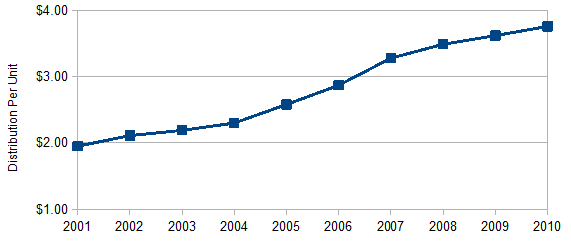For income-deprived investors, the oil and gas sector is a great place to search for dividend stocks. While some investors shun big oil companies for their poor environmental track record, the truth is that some of these companies have been the best payers of dividends over the long term.
Energy stocks have a long history of consistently paying and increasing their dividend payments. Indeed, Chevron (NYSE: CVX) and ExxonMobil (NYSE: XOM) have been two of the most persistent and reliable dividend payers over the past 100 years.
But as great as ExxonMobil and Chevron are, the yields offered by these stocks today are relatively low. In fact, both pay shareholders less than three percent. While this may appear attractive compared with the two-percent yield on the 10-year U.S. Treasury, the payout still isn’t generous enough to attract investors seeking a decent income from their investments.
While the big, full-integrated oil companies like Chevron and ExxonMobil fail to deliver high yield to investors, many small- and mid-sized energy companies offer far more attractive dividends. Today, I’ll tell you about two of my favorites.
An All-American Energy Investment
Plains All-American Pipeline LP (NYSE: PAA) is one of those firms. The company is one of the largest natural gas and oil distributors in North America. It owns an extensive array of storage facilities and 16,000 miles of pipeline throughout the United States and Canada.
Founded in 1998, Plains has grown far faster than the big integrated energy companies. Between 2001 and 2010, revenue more than tripled to $25.9 billion. Meanwhile, the balance sheet remains solid, with long-term debt holding its historical balance at 50 percent of total capitalization.
Of course, income investors are most interested in what a firm can deliver to them – namely cash in the form of dividend payments.
On that front, Plains has consistently delivered sustainable and predictable cash flow to investors over many economic and commodity cycles. Over the past 10 years, earnings per share have more than tripled to $3.76 from $1.02, while cash distributions have nearly doubled to $3.76 from $1.95. Not only has the payout grown over the long term, but the dividend has also risen every year without fail.

Management’s stated goal is to increase the distribution at an annual rate of five percent. Historically, the distribution is usually increased at least twice a year. Given management’s exceptional history managing market fluctuations and company cash flows and distributions, I see no reason why investors should expect the dividend growth to end anytime soon.
I always find it heartening when others agree with my analysis. Credit Suisse, in a recent analyst’s note, said that it expects distributions to total $3.96 this year, $4.16 in 2012, and $4.33 in 2013. Credit Suisse’s estimate is in line with five percent annual growth.
Because of Plains’ long and outstanding operating history, I view it as a core energy holding for any income investor’s portfolio, and one that delivers twice the yield of energy behemoths Chevron and ExxonMobil. With a current dividend yield of six percent and growing, this stock should be on every income investor’s watch list.
An Apple That Didn’t Fall Far From the Tree
For investors seeking higher yields, take a look at PAA Natural Gas Storage (NYSE: PNG), whose business is providing large underground natural-gas storage facilities. The company was spun off from Plains All-American Pipelines in 2010, and currently pays out an attractive 7.7 percent yield.
After the spin-off, Plains still owns 65 percent of PNG’s publicly traded shares. The same great leadership team at Plains operates PAA Natural Gas. Thus far, management has proven to be as capable in managing natural gas storage as it is in managing oil and gas transportation.
You might think PNG would have volatile earnings and cash flow given that its focus is natural gas – a notoriously volatile commodity. And yet, a high percent of PNG’s customers are committed to multi-year contracts.
Due to a supply glut in the market, natural gas prices are low today. Whatever the market price, though, that gas must be stored somehow, and PNG provides the storage facilities.
PNG’s shares are trading 25 percent below their 52-week high of $25.75. Shares have moved lower recently based on the misperception that PNG’s success is linked directly with spot prices for natural gas.
However, even with the price of natural gas at multi-year lows, PNG remains profitable and continues to raise its dividend distributions. In fact, the next raise will come this month, when the quarterly distribution is upped to $0.3575 per share. PNG can easily cover that distribution considering the company has been generating cash flow at an annual rate of $1.63 per share over the past 12 months.
In short, PNG is the classic example of a high-yield, well-run company that’s been discounted because of a depressed market for natural gas. Over the years, such firms have proven to be highly profitable for patient investors. I believe that remains true today.
Plains All-American, and its publicly traded carve-out PAA Natural Gas Storage, each appeal to a certain type of investor:
Plains All-American offers risk-averse investors a reliable, market-beating stream of cash distributions. PAA Natural Gas offers a higher level of distributions for less risk-averse investors willing to focus on a market niche.
Both firms offer access to an exceptional oil and gas management team whose focus is generating cash flow for its investors, as well as dividends that far exceed most in the oil and gas sector. For long-term income investors, both stocks are worth a closer look.
Steve Mauzy
Research Analyst, High Yield Wealth
Aurora, Colorado
 Facebook
Facebook
 Twitter
Twitter